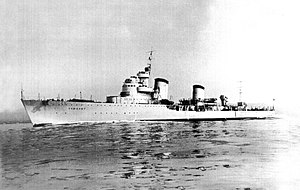
Back Taškent (1937) Czech Taschkent (Schiff) German Tashkent (1940) Spanish Kapal perusak Soviet Tashkent ID タシュケント (嚮導駆逐艦) Japanese Taszkient (1937) Polish Ташкент (лидер эскадренных миноносцев) Russian Ташкент (лідер ескадрених міноносців) Ukrainian Toshkent kemasi Uzbek
 Tashkent on her builder's sea trials, 1937
| |
| History | |
|---|---|
| Name | Tashkent (Ташкент) |
| Namesake | Tashkent |
| Ordered | 2nd Five-Year Plan |
| Awarded | September 1935 |
| Builder | OTO, Livorno, Italy |
| Laid down | 11 January 1937 |
| Launched | 28 December 1938 |
| Completed | 22 October 1939 |
| Nickname(s) | "Blue Beauty" or "Blue Cruiser"[1] |
| Fate | Sunk by aircraft, 2 July 1942 |
| General characteristics (September 1941) | |
| Class and type | Tashkent-class destroyer leader |
| Displacement | 2,840 long tons (2,890 t) (standard) |
| Length | 139.7 m (458 ft 4 in) (o/a) |
| Beam | 13.7 m (44 ft 11 in) |
| Draft | 3.7 m (12 ft 2 in) |
| Installed power |
|
| Propulsion | 2 shafts; 2 geared steam turbines |
| Speed | 42.5 knots (78.7 km/h; 48.9 mph) |
| Range | 5,030 nmi (9,320 km; 5,790 mi) at 20 knots (37 km/h; 23 mph) |
| Complement | 250 |
| Armament |
|
Tashkent (Russian: Ташкент) was the lead ship of her class of destroyer leaders (officially known as Project 20), built in Italy for the Soviet Navy just before World War II. The problems of the previous Leningrad-class destroyer leaders demonstrated that Russian design experience had atrophied in the years since the Russian Revolution of 1917, and the Soviets contracted for design assistance from Fascist Italy in the mid-1930s. Delivered without any armament in 1939, Tashkent was given a temporary gunnery outfit when she entered service with the Black Sea Fleet later that year. She had her permanent armament installed shortly before the Axis Powers invaded the Soviet Union in mid-1941.
During the Siege of Odessa the ship escorted a transport to Odessa and provided naval gunfire support before she was badly damaged by Axis bombers in August. After repairs were completed in November, Tashkent ferried reinforcements and supplies, evacuated wounded and refugees, and bombarded Axis positions during the Siege of Sevastopol in 1941–1942. The last ship to enter Sevastopol harbor in June before the city surrendered, she was crippled by Axis bombers on her return voyage to Novorossiysk and was sunk a few days later during an air strike on the harbor there. Her wreck was refloated in 1944, but it was a constructive total loss and was scrapped after the war.
© MMXXIII Rich X Search. We shall prevail. All rights reserved. Rich X Search